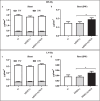Nitric oxide synthase expression in Pseudomonas koreensis MME3 improves plant growth promotion traits
- PMID: 38358431
- PMCID: PMC10869383
- DOI: 10.1007/s00253-024-13029-1
Nitric oxide synthase expression in Pseudomonas koreensis MME3 improves plant growth promotion traits
Abstract
The development of novel biotechnologies that promote a better use of N to optimize crop yield is a central goal for sustainable agriculture. Phytostimulation, biofertilization, and bioprotection through the use of bio-inputs are promising technologies for this purpose. In this study, the plant growth-promoting rhizobacteria Pseudomonas koreensis MME3 was genetically modified to express a nitric oxide synthase of Synechococcus SyNOS, an atypical enzyme with a globin domain that converts nitric oxide to nitrate. A cassette for constitutive expression of synos was introduced as a single insertion into the genome of P. koreensis MME3 using a miniTn7 system. The resulting recombinant strain MME3:SyNOS showed improved growth, motility, and biofilm formation. The impact of MME3:SyNOS inoculation on Brachypodium distachyon growth and N uptake and use efficiencies under different N availability situations was analyzed, in comparison to the control strain MME3:c. After 35 days of inoculation, plants treated with MME3:SyNOS had a higher root dry weight, both under semi-hydroponic and greenhouse conditions. At harvest, both MME3:SyNOS and MME3:c increased N uptake and use efficiency of plants grown under low N soil. Our results indicate that synos expression is a valid strategy to boost the phytostimulatory capacity of plant-associated bacteria and improve the adaptability of plants to N deficiency. KEY POINTS: • synos expression improves P. koreensis MME3 traits important for rhizospheric colonization • B. distachyon inoculated with MME3:SyNOS shows improved root growth • MME3 inoculation improves plant N uptake and use efficiencies in N-deficient soil.
Keywords: Brachypodium; Nitric oxide synthase; Nitrogen; Plant growth–promoting rhizobacteria; Pseudomonas.
© 2024. The Author(s).
Conflict of interest statement
The authors declare no competing interests.
Figures






Similar articles
-
Cyanobacterial NOS expression improves nitrogen use efficiency, nitrogen-deficiency tolerance and yield in Arabidopsis.Plant Sci. 2021 Jun;307:110860. doi: 10.1016/j.plantsci.2021.110860. Epub 2021 Feb 28. Plant Sci. 2021. PMID: 33902845
-
A singular nitric oxide synthase with a globin domain found in Synechococcus PCC 7335 mobilizes N from arginine to nitrate.Sci Rep. 2018 Aug 21;8(1):12505. doi: 10.1038/s41598-018-30889-6. Sci Rep. 2018. PMID: 30131503 Free PMC article.
-
A nitric oxide synthase-like protein from Synechococcus produces NO/NO3- from l-arginine and NADPH in a tetrahydrobiopterin- and Ca2+-dependent manner.J Biol Chem. 2019 Jul 5;294(27):10708-10719. doi: 10.1074/jbc.RA119.008399. Epub 2019 May 20. J Biol Chem. 2019. PMID: 31113865 Free PMC article.
-
Insight into soil nitrogen and phosphorus availability and agricultural sustainability by plant growth-promoting rhizobacteria.Environ Sci Pollut Res Int. 2022 Jun;29(30):45089-45106. doi: 10.1007/s11356-022-20399-4. Epub 2022 Apr 26. Environ Sci Pollut Res Int. 2022. PMID: 35474421 Review.
-
Microbes in Agriculture: Prospects and Constraints to Their Wider Adoption and Utilization in Nutrient-Poor Environments.Microorganisms. 2024 Nov 2;12(11):2225. doi: 10.3390/microorganisms12112225. Microorganisms. 2024. PMID: 39597614 Free PMC article. Review.
Cited by
-
Maize drought protection by Azospirillum argentinense Az19 requires bacterial trehalose accumulation.Appl Microbiol Biotechnol. 2024 Dec 27;108(1):543. doi: 10.1007/s00253-024-13391-0. Appl Microbiol Biotechnol. 2024. PMID: 39729258 Free PMC article.
References
-
- Altaf MM, Ahmad I (2019) In vitro biofilm development and enhanced rhizosphere colonization of Triticum aestivum by fluorescent Pseudomonas sp. J Pure Appl Microbiol 13:1441–1449. 10.22207/JPAM.13.3.14
-
- Arruebarrena Di Palma A, Pereyra MC, Moreno Ramirez L, Xiqui Vázquez ML, Baca BE, Pereyra MA, Lamattina L, Creus CM (2013) Denitrification-derived nitric oxide modulates biofilm formation in Azospirillum brasilense. FEMS Microbiol Lett 338:77–85. 10.1111/1574-6968.12030 - PubMed
-
- Banaei-Asl F, Farajzadeh D, Bandehagh A, Komatsu S (2016) Comprehensive proteomic analysis of canola leaf inoculated with a plant growth-promoting bacterium, Pseudomonas fluorescens, under salt stress. Biochim Biophys Acta Proteins Proteom 1864:1222–1236. 10.1016/j.bbapap.2016.04.013 - PubMed
-
- Bao Y, Lies DP, Fu H, Roberts GP (1991) An improved Tn7-based system for the single-copy insertion of cloned genes into chromosomes of Gram-negative bacteria. Gene 109:177–178. 10.1016/0378-1119(91)90604-A - PubMed
-
- Basu A, Prasad P, Das SN, Kalam S, Sayyed RZ, Reddy MS, El EH (2021) Plant growth promoting rhizobacteria (PGPR) as green bioinoculants: recent developments, constraints, and prospects. Sustainability (switzerland) 13:1140
MeSH terms
Substances
Supplementary concepts
Grants and funding
LinkOut - more resources
Full Text Sources

